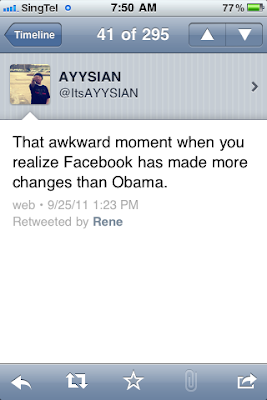I gave an unconscious nod when I saw this tweet:
Facebook is turning into a bigger and bigger giant day in and out. It is always evolving into a platform for sharing more of your life, never less. It’s one online scrapbook that interconnects you with everybody else who has online presence in the web.
Updated with Facebook’s New Leap: Facebook Timeline
According to many sources, the new format, Facebook Timeline, should be available to all Facebook users within the next two weeks. So keen, I had found a way to be one of the first users of the change release. And excited much, last Monday, I have activated the Facebook Timeline and changed the layout of my profile with the help of tips from TechCrunch. My page now looks like this:
Better Data Visualization
As compared to the old design, the change is quite a massive one. If you noticed, as shown above, aside from your profile photo which is the only thing customizable in Facebook (and nothing else like layout of widgets, background design, other personalization and CSS stuff), now you can have a cover which is a banner picture that goes across the front of your page.
Then on the right side, you can scroll your profile’s timeline by month or by year. One click allows you to scan through old memories you can heartily reminisce with–the pictures you’ve uploaded, the funny funny links and snippets of stories you’ve shared, your emo and cheesy status messages and your friends’ comments and reactions all over again.
It tracked me back and helped me remember my first encounter with the site. It was on May 26, 2008. My first friends were Henshel, Gianne and my sister, Leigh.
It was only on December that year when Louie and I became friends in Facebook. I remember I was the one who pushed him to create an account. Oh oh oh. 3:)
The timeline also offers assigning of a photo to your previous and current jobs.
Inadvertent Over-sharing?
What I’m just concerned about is the privacy this social network holds. In this new format, there is more “self-expression,” which means your friends will know a lot more about what you read, what music you listen to and videos you watch.
The term that fits in the scenario is “passive sharing.” Also be careful when authorizing apps because once you add it onto your timeline, it will automatically be permitted to add posts to your feed that your friends and subscribers will see.
There’s also the fact that Facebook tracks your data even if you’ve already logged out. You can read more about it here.
My Say
This move by Facebook will result in more diversity. Friends (and subscribers) can view your interests in a more granular aspect. Your life will be more presented to the public and project slices of your life translated to Facebook’s version of reality.
I think one of the main reasons Facebook did this is that the personal updates, settings and preferences shared by individuals online will be much more “targetable,” from a marketing perspective.
The negative thing as I see rightly state is that Facebook is pulling more partners in, which is the opposite of what I personally believe the web should become (i.e. more about you and less about the advertisers). I believe that data should be something centered on the individual and in the individual’s control and benefit.
The best way to summarize the change is that users are no longer sharing what they’re doing. Your Internet history is sharing what you’re consuming. However, like it or not, Facebook will go on without you. So better move on with it, else stay ignorant, resistant to change and hide—under a boulder in the hinterlands.


Leave a Reply